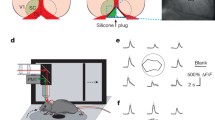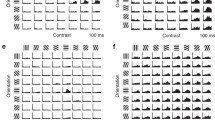Abstract
Selectivity and invariability of tuning were studied in 51 neurons of the primary visual cortex (area 17); cruciform and angular figures (CF and AF, respectively) of different configurations and orientations were presented in their receptive fields. Twenty-three neurons, or 45% of the studied cells, demonstrated selective sensitivity to these figures. Their responses considerably (2.38±0.36 times, on average) increased, as compared with those evoked by presentation of a single bar of preferred orientation. In the examined group, 2 cells demonstrated sensitivity both to the CF and AF. A wide range of detector properties related to the CF and AF analysis was found in the analyzed neuronal population. Detectors of configuration of these figures are described. Selective sensitivity to the angle between branches of these figures was observed in 17 neurons, and responses of 2 neurons among them showed invariability to orientation of these figures. Four cells were selective for orientation and were insensitive to configuration, and 4 other cells showed no specific sensitivity to either of these properties, but were sensitive to the appearance of a CF itself in their receptive field (these cells were regarded as invariant detectors of crossing nodes). Data inconsistent with the hierarchic principle of detection of the above properties are presented. Possible mechanisms and functional significance of selective sensitivity of striate neurons to the CF and AF are discussed.
Similar content being viewed by others
References
I. A. Shevelev, N. A. Lazareva, R. V. Novikova, et al., “Tuning for cruciform stimuli in visual cortex neurons of cat,”Neirofiziologiya/Neurophysiology,1, No. 5, 362–365 (1993).
I. A. Shevelev, N. A. Lazareva, R. V. Novikova, et al., “Double orientation tuning of units in cat visual cortex,”Neuroscience,61, No. 4, 965–973 (1994).
I. A. Shevelev, R. V. Novikova, N. A. Lazareva, et al., “Sensitivity to cross-like figures in the cat striate neurons,”Neuroscience,69, No. 1, 51–57 (1995).
I. Fujita, K. Tanaka, M. Ito, and K. Cheng, “Columns for visual features of objects in monkey inferotemporal cortex,”Nature,360, No. 6402, 343–346 (1992).
K. Sakai and Y. Miyashita, “Neural organization for the long-term memory of paired associates,”Nature,354, No. 6349, 152–155 (1991).
D. Marr and C. E. Hildreth, “A theory of edge detection,”Proc. Roy. Soc. Ser. B,204, 301–328 (1980).
G. M. Zenkin and A. P. Petrov, “A system for analysis of images and identification of objects against the complex background,”Biofizika,12, No. 3, 493–501 (1967).
P. Hammond and D. P. Andrews, “Orientation tuning of cells in areas 17 and 18 of the cat's visual cortex,”Exp. Brain Res.,31, No. 3, 341–351 (1978).
G. H. Henry, B. Dreher, and P. O. Bishop, “Orientation specificity of cells in cat striate cortex,”J. Neurophysiol.,37, No. 6, 1394–1409 (1974).
D. H. Hubel and T. N. Wiesel, “Receptive fields, binocular interaction and functional architecture in the cat's visual cortex,”J. Physiol.,160, No. 1, 106–154 (1962).
R. P. Scobey and A. J. Gabor, “Orientation discrimination sensitivity of single units in cat primary visual cortex,”Exp. Brain Res.,77, No. 2, 398–406 (1989).
H. M. Buchanan-Smith and D. W. Heeley, “Anisotropic axes in orientation perception are not retinotopically mapped,”Perception,22, No. 12, 1389–1402 (1993).
D. W. Heeley and H. M. Buchanan-Smith, “Recognition of stimulus orientation,”Vision Res.,30, No. 11, 1429–1437 (1990).
B. D. Burns and R. Pritchard, “Geometrical illusions and the response of neurones in the cat's visual cortex to angle patterns,”J. Physiol.,213, No. 3, 599–616 (1971).
R. H. S. Carpenter and C. Blakemore, “Interactions between orientations in human vision,”Exp. Brain Res.,18, No. 3, 287–303 (1973).
E. S. Eriksson, “A field theory of visual illusions,”Br. J. Psychol.,61, No. 3, 451–466 (1970).
D. H. Perkel and T. H. Bullock, “Neural coding,” in:Neurosci. Res. Symp., Summ. Vol. 6 (1969), pp. 405–527.
G. M. Ghose, R. D. Freeman, and I. Ohzawa, “Local intracortical connections in the cat's visual cortex: postnatal development and plasticity,”J. Neurophysiol.,72, No. 6, 1290–1303 (1994).
R. Ben-Yishai, R. L. Bar-Or, and H. Sompolinsky, “Theory of orientation tuning in visual cortex,”Proc. Natl. Acad. Sci. USA,92, 3844–3848 (1995).
Author information
Authors and Affiliations
Additional information
Neirofiziologiya/Neurophysiology, Vol. 27, No. 5/6, pp. 403–412, September–December, 1995.
Rights and permissions
About this article
Cite this article
Lazareva, N.A., Shevelev, I.A., Novikova, R.V. et al. Selective sensitivity of the cat striate neurons to cruciform and angular figures of various orientations. Neurophysiology 27, 321–328 (1995). https://doi.org/10.1007/BF01081911
Received:
Issue Date:
DOI: https://doi.org/10.1007/BF01081911




